Last September 10, residents of California cities, particularly San Francisco, Oakland and Berkeley beheld an eerie sight of orange skies. Such was the result of wildfires raging in the US West Coast, their smoke and ash blotting out sunlight and creating the rust-colored haze.
According to the California Department of Forestry and Fire Protection, the wildfires began as early as January, and have already burned down more than 3 million acres in the state. Since the increased fire activity last August 15, there have been 24 deaths and over 4,000 damaged structures. But outside these figures, the wildfires have wreaked havoc in the atmosphere, putting areas under Air Quality Indexes of “very unhealthy” and even “hazardous”, forcing residents to stay indoors.
 Orange-tinged skies in the Bay Area in San Francisco last Sept. 10 at 10:30 a.m. (photo by Irma Cruz-Dimaisip)
Orange-tinged skies in the Bay Area in San Francisco last Sept. 10 at 10:30 a.m. (photo by Irma Cruz-Dimaisip)
The Pollution Problem
Even without the wildfires, ambient air pollution is a global problem, causing over 4 million deaths each year. According to the Centre for Research on Energy and Clean Air, pollutants are linked to severe respiratory and heart diseases, and lowers resistance against airborne viruses, making one vulnerable during the COVID-19 pandemic.
According to the World Health Organization (WHO), these human activities are the major sources of outdoor pollution:
- Fuel combustion from motor vehicles (e.g. cars and heavy duty vehicles)
- Heat and power generation (e.g. oil and coal power plants and boilers)
- Industrial facilities (e.g. manufacturing factories, mines, and oil refineries)
- Municipal and agricultural waste sites and waste incineration/burning
- Residential cooking, heating, and lighting with polluting fuels
- Poor urban planning, which leads to over-dependence on private vehicles
Combustion engines, fossil fuels and industrial activities produce Particulate Matter (PM), which contains sulphate, nitrates, ammonia, sodium chloride, black carbon, mineral dust and water. Most dangerous is PM2.5, which has a diameter of less than 2.5 micrometers. Because of its tiny size, PM2.5 is easily inhaled, allowing it to penetrate the lungs and blood stream, causing illnesses, which may lead to premature death.
WHO data further states that more than 80% of people living in urban areas that monitor air pollution are exposed to air quality levels that exceed WHO guideline limits. The most affected countries with the greatest toll are in the Western Pacific— and Southeast Asia, which includes the Philippines.
 Aerial view of the Pasig River (photo by Enrico Empainado/Greenpeace)
Aerial view of the Pasig River (photo by Enrico Empainado/Greenpeace)
Metro Manila’s Alarming Air Quality
Greenpeace Philippines reported a dramatic improvement in air quality during the enhanced community quarantine (ECQ) in Metro Manila from March 15 to May 15, 2020. With this measure to curtail the spread of COVID-19, most of the National Capital Region’s 2.5 million vehicles were kept off the road, resulting in PM2.5 levels dropping by an astounding 180%.
But this improvement was short-lived. Since the region shifted to general community quarantine (GCQ) last June 1, smog and pollution levels continue to climb, slowly reverting to the poor air quality experienced before ECQ.
Prior to the lockdown last February, groups such as Greenpeace, Clean Air Asia and the Center for Energy, Ecology and Development (CEED), Health Care without Harm, the Philippine Movement for Climate Justice (PMCJ), and the World Wildlife Fund for Nature (WWF) Philippines had called on the government to overhaul its monitoring and analysis of air pollution data to provide more accurate information. This was in response to the recent 2019 Air Visual report, which placed the Philippines in the 58th spot out of 98 countries. The groups argued that though the country’s ranking wasn’t high, data still showed that the country’s air quality was getting worse. In 2018, the country’s air pollution level of 17.6 micrograms per cubic meter was well beyond WHO’s safety limit of 10 micrograms per cubic meter.
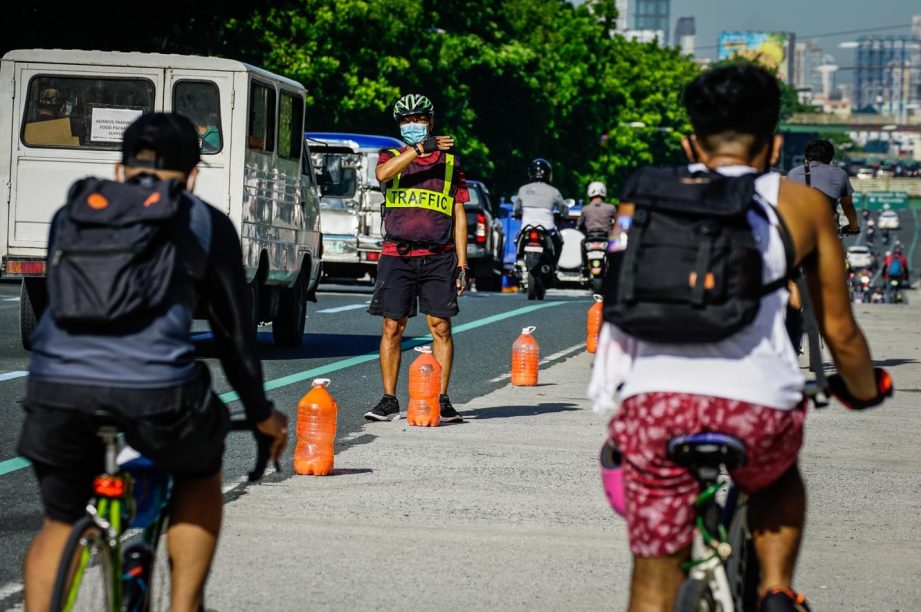 Bikers during ECQ (photo by Jire Carreon)
Bikers during ECQ (photo by Jire Carreon)
A Greenpeace Philippines report released in February, showed that toxic emissions could cost Filipinos as much as a 1.9% loss in Gross Domestic Product, as well as 27,000 premature deaths. For a clearer picture of the country’s air pollution, the groups urge the government to place monitoring stations near coal-driven power plants and areas of high traffic.
“The Philippine government should see the data as an impetus to overhaul air quality monitoring systems in the country, as well as to transition away from highly polluting facilities such as coal plants. Our safety standards for air pollution haven’t changed since 1999,” said Khevin Yu, campaigner of Greenpeace Philippines. “This situation has allowed industries and facilities to pollute the air we breathe with impunity.”
Meanwhile, Greenpeace campaigner Rhea Jane Pescador-Mallari believes that the ECQ showed Filipinos that healthy, clean air is possible in the metro. “Moving forward, if the government is willing to use the opportunities and lessons learned from the pandemic and amplify it through policies and infrastructure, active mobility and micro mobility, as well as invest in efficient and safe mass public transport, then a return to the massive pollution levels before COVID-19 can be avoided.”
Clean Air for All
The severity of recent global wildfires are fueled by climate change, which brings about soaring temperatures, drier conditions and pest outbreaks that weaken trees. According to WHO, air pollutants like black carbon and methane contribute to global warming and glacial melt. The Climate and Clean Air Coalition also states that air pollution threatens food and water supply by blocking sunlight, and affecting the movement and intensity of monsoons.
To secure the Filipinos’ health, Greenpeace Philippines advocates for the stricter implementation of the Clean Air Act, and the following measures:
- Maintaining flexible remote work arrangements or staggered work shifts, where possible
• People-centric urban design, where public spaces should be planned in parallel with the establishment of mobility programs
• Rebuilding trust in mass transit and supporting displaced transportation workers, possibly with LGU-centric green mobility services - Low-cost, active and carbon-neutral transport options that enable micro-mobility
• Tightening vehicle emission standards from Euro 2 to 4 to 6, and implementing accordingly
• Developing capabilities for real-time monitoring of dangerous pollutants in cities
• Strengthening industrial air pollution standards and wider adoption of renewable energy
Greenpeace believes that the efforts to solve air pollution are the same ones needed to mitigate the climate crisis. “As epicenters of growth, cities need to provide an environment that puts in high premium the health and wellness of both people and the planet. At the local level, addressing air pollution is a key aspect of making cities livable and sustainable. At the national level, it means addressing the climate crisis while helping build climate-resilient communities,” said Mallari.
The COVID-19 pandemic continues to be in full swing with currently over 20 million confirmed cases worldwide. In the Philippines, the total number of cases has reached 148,000 with over 2,000 people dying from the disease.
But the pandemic isn’t the only crisis the country faces. Right now, the Philippines is in the middle of typhoon season. According to the Philippine Atmospheric, Geophysical and Astronomical Services Administration (PAGASA), more tropical cyclones enter the Philippine Area of Responsibility (PAR) than anywhere else in the world each year. An annual average of 20 tropical cyclones develop in the region, 8 to 9 of them traversing the Philippines.
The peak of typhoon season, wherein 70% of typhoons develop, happens between July to October. According to PAGASA, the country may experience 8 to 13 tropical cyclones from August until the end of the year. More than ever, Filipinos need the weather bureau’s comprehensive and reliable forecasts to help them ensure their safety this pandemic.
 Source: PAGASA
Source: PAGASA
Getting to Know PAGASA
PAGASA traces its roots back to the Observatorio Meteorologico de Manila (now Manila Observatory) a scientific research institution established by the Jesuits in 1865. Involved in the systemic observation of Philippine weather, it first issued typhoon warnings in 1880.
In 1901, the observatorio was re-organized and was formally named as the state’s weather bureau. Today, PAGASA, under the Department of Science and Technology (DOST) is mandated to “provide protection against natural calamities and utilize scientific knowledge as an effective instrument to ensure the safety, well-being and economic security of all the people, and for the promotion of national progress.” (Section 2, Statement of Policy, Presidential Decree No. 78; December 1972 as amended by Presidential Decree No. 1149; August 1977)
With its mission to be a center of excellence for weather-related information, PAGASA seeks to protect lives and properties through its following products and services:
- weather forecasts and tropical cyclone warning
- flood forecasts and warnings
- climatological and farm weather
- research and development
- information, education, and public outreach
- astronomical services
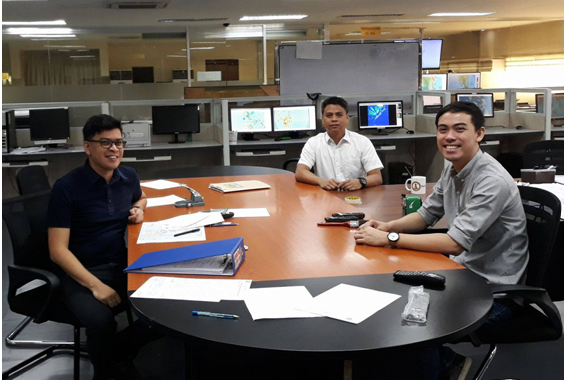 PAGASA weather forecasters before the pandemic (L-R: Nikos Peñaranda, Chris Perez, Ariel Rojas)
PAGASA weather forecasters before the pandemic (L-R: Nikos Peñaranda, Chris Perez, Ariel Rojas)
PAGASA and the Pandemic
The pandemic impacted public mobility, businesses, services, and many other aspects of daily living. According to Chris Perez, PAGASA spokesperson and senior weather specialist, the weather bureau was no exception. “The restrictions put into effect by the national government to prevent the further spread of the virus affected PAGASA’s day-to-day operations in the sense that only a few personnel are required to report to the office. This posed a great challenge in ensuring the continuous delivery of the agency’s products and services despite the limited manpower.”
PAGASA’s limited physical manpower at the office has been supported by work-from-home personnel since the Enhanced Community Quarantine (ECQ) last March 16. Those assigned to report to office are provided company transportation from their homes to the office then back to their homes after a 3-day or 5-day work assignment. Perez adds, “The same personnel are given grocery allowances, and sleeping quarters to rest after their duty. Key personnel such as the PAGASA Administrator and higher officials report to the office when needed—during the event of a tropical cyclone, the processing of payrolls, and other duties.”
Because health vigilance is a must during the pandemic, PAGASA’s weather division has formed a committee to oversee the health and well-being of its employees—both in the office and working from home. “This ensures that the appropriate number of working personnel is met whenever the situation warrants,” Perez explains. “In the case of a personnel getting ‘sick’ and not being able to report for work, this committee will handle the matter in accordance with the national government’s established health protocols.”
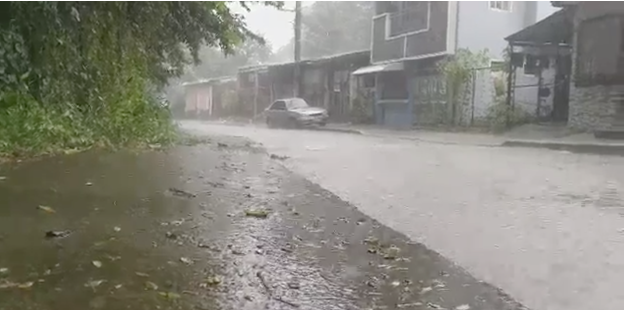 The habagat may enhance tropical cyclones, bringing more rains in the country. (Photo by PM Caisip)
The habagat may enhance tropical cyclones, bringing more rains in the country. (Photo by PM Caisip)
Currently, PAGASA holds webinars to conduct climate forums and educate sectors on the natural hazards the rainy season brings. During the National Disaster Resilience Month last July, PAGASA’s webinars targeted religious organizations and focused on preparedness among children.
Season of both Typhoons and the Pandemic
Since the government’s announcement of the country’s first COVID-19 case in January, 7 tropical cyclones have entered the PAR as of writing.
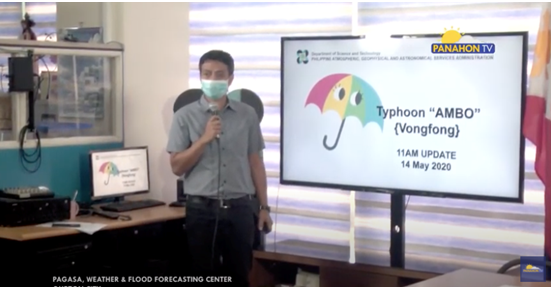 Perez holding a press briefing for Typhoon Ambo last May
Perez holding a press briefing for Typhoon Ambo last May
May 14
Typhoon Ambo (international name: Vongfong) made its first landfall in Eastern Samar. PAGASA recorded five more landfalls that weakened the weather system before it headed inland to Luzon. According to the National Disaster Risk Reduction and Management Council (NDRRMC) last May 20, Ambo caused an estimated damage of Php2 billion in agriculture and infrastructure, and left 5 people dead.
June 11
Tropical Depression Butchoy (international name: Nuri) made its first landfall in Pollilo Island in Quezon. Because Butchoy was expected to produce heavy rainfall in Albay, , the province was placed under disaster “response status.” Butchoy’s rains prompted PAGASA to declare the start of the rainy season in the country last June 12.
July 13
Tropical Depression Carina headed for the Luzon Strait near Batanes and Cagayan. Before leaving, the weather disturbance left over PHP19-million worth of damage in Ilocos Norte in crops and properties.
August 1
Dindo (international name: Hagupit) strengthened from a tropical depression into a tropical storm on August 1. Though Dindo enhanced the southwest monsoon (habagat), bringing more rains, Dindo did not have a direct impact on the country, and exited PAR on August 3.
August 8
PAGASA upgraded a weather disturbance into Tropical Depression Enteng (international name: Jangmi). The next day, it intensified into a tropical storm, enhancing monsoon rains in MIMAROPA, Pangasinan, Benguet, Zambales, Bataan and Antique.
August 9
Just seven hours after Enteng left PAR, Tropical Depression Ferdie developed, raising Public Storm Warning Signal No. 1 in parts of Luzon. While maintaining its strength, Ferdie exited PAR on August 13.
August 13
Tropical Depression Gener entered PAR. No public storm warning signal was raised since Gener was expected to weaken as it moved westward of PAR.
PAGASA’s Crucial Role
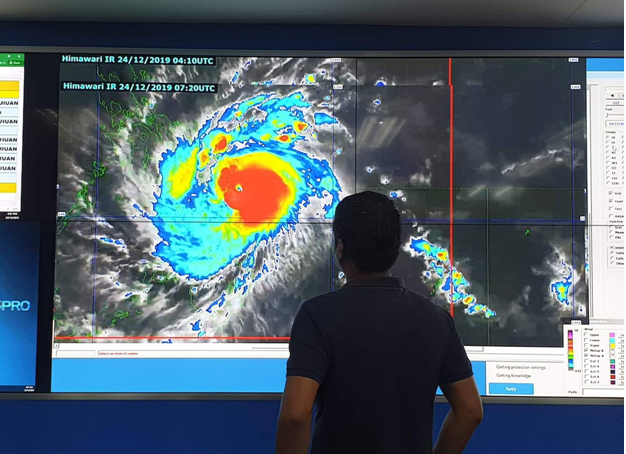 Perez studying a tropical cyclone’s movement
Perez studying a tropical cyclone’s movement
Even before the pandemic, PAGASA has always been an important source of information essential to public health and safety. “PAGASA’s products and services are of vital importance in day-to-day activities,” Perez says. “Matters related to the pandemic can be planned and executed—such as the transport of medical personnel, products and services, or even the usual buying of groceries and medicines of the general public—in accordance with the expected weather.”
Weather forecasts are even more relevant now that natural disasters such as typhoons can hamper health services and damage health infrastructure. According to Christopher Trisos, director of the African Climate and Development Initiative at the University of Cape Town in South Africa, natural disasters can also disrupt the supply of clean water and eat into government budgets already stretched thin by the pandemic response. Physical distancing is also challenging in often-crowded evacuation centers.
Last May, India and Bangladesh were ravaged by Category 5 Hurricane Amphan, leaving over a hundred dead and displacing thousands of families. Partnered with the pandemic, the disaster can impact even more lives.
In the Philippines, the second half of the year marks the time when most tropical cyclones directly affect the country. And coupled with the habagat season commencing from July to September, tropical cyclones can bring continuous moderate to heavy, and even at times, torrential rains, which may cause flooding in low-lying areas and landslides near mountain slopes. These winds and rains, regularly experienced during this period, may inflict damage to properties, causing disruptions in major services such as power, transportation, health and food. “There is a tendency that the current situation may worsen—such as an increase in the number of affected persons or casualties— when there is a disruption to the provision of the these products and services due to weather-related hazards,” Perez explains.
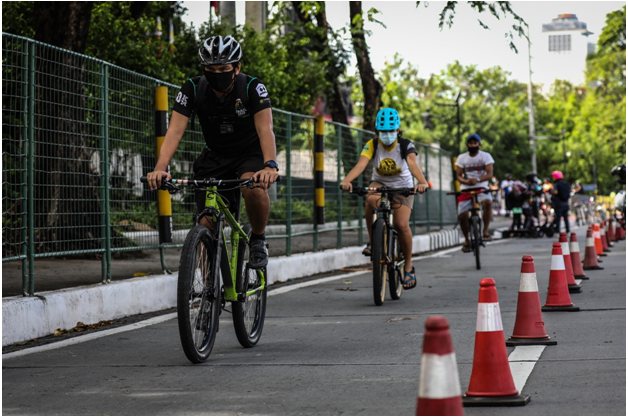 The typhoon season may worsen public mobility already hampered by the pandemic. (photo by Jire Carreon)
The typhoon season may worsen public mobility already hampered by the pandemic. (photo by Jire Carreon)
Right now, PAGASA is testing a new prediction model called the 2-Week Tropical Cyclone Threat Potential Forecast that shows the development of cyclones two weeks before they occur. The agency’s researchers developed this weather forecasting model in partnership with Taiwan’s Central Weather Bureau.
The situation may look grim, but Perez says we can do our part in alleviating it. While we can’t stop weather systems from entering our country, we can slow down the rise of COVID-19 cases in the country. “Heed the government’s call to just stay at home as much as possible, and follow the established health protocols being implemented,” Perez urges. “Lastly, make it a habit to monitor every day the various PAGASA weather updates as these may guide you in planning your day-to-day activities.”
- With additional reports from George Gamayo
Weather plays an important role in our lives. By monitoring the weather, we are equipped to handle our routines and are prepared for possible hazards.
But in this day and age where ideas can be disseminated with the click of a mouse, it’s our responsibility to verify before sharing them. To get you started, here are some weather myths that need to be debunked.
1) Climate and weather are the same.
This is one of the most common weather misconceptions that can be clarified by understanding one important factor – time.
Weather refers to the condition of the atmosphere over a short period of time. It is what we experience when we step outside on any day: sunny, windy, cloudy, rainy or stormy. Climate, on the other hand, refers to how the atmosphere behaves over a relatively long period of time, usually 30 years or more.
2) Lightning never strikes the same place twice.
Originating from an idiom which means that a highly unlikely incident can never happen to the same person twice, this myth–when taken seriously— can actually lead to misfortune.
The truth is that tall, pointed, isolated objects can generate strong electric fields that can be repeatedly struck by lightning.
In the Philippines for example, lightning has struck the Metro Rail Transit lines thrice in the past years, halting operations. In fact, the National Aeronautics and Space Administration (NASA) explained that cloud-to-ground lightning frequently strikes the ground in two or more places. The chances of being struck are about 45% higher than what most of us commonly assume.
3) Sun + Rains = Tikbalang Wedding
According to Philippine folklore, whenever rains fall while the sun is shining, it means that a mythical creature called tikbalang (a half-human, half horse trickster that hangs out in the forests and mountains, leading travelers astray) is being wed.
PAGASA explains that both sunshine and rain may occur at the same time during the Hot and Dry Season. Called “sun showers”, this happens when the ground surface heats up, resulting to a vertical movement of warm air. This forms clouds that bring precipitation while the sun is at a 30-degree angle from the earth. This weather phenomenon most likely occurs in the months of March, April and May.
4) There is summer in the Philippines.
Summer vacations, summer adventures and summer getaways are some phrases we off-handedly use during school break from March to May. do you know that there is no summer here in the country?
According to PAGASA, the Philippines, being a tropical country, has only two official seasons – wet and dry. A season refers to the time of the year caused by the tilting of the Earth. The location of an area, whether it is in the northern or southern hemisphere, affects its seasons. Other regions have complete seasons: winter, spring, summer and fall.
In Philippine context, the Hot and Dry Season is the equivalent of summer. This marks the start of warm and humid days.
The online community is abuzz after a Miss Earth Philippines contestant shared her insights in the Q & A portion of the beauty pageant.
During the coronation night last June 11, candidates were each given 30 seconds to elaborate on trending topics they had picked from a basket.
Miss Zamboanga, Bellatrix Tran, drew #ElNiñoLaNiña, two weather-related events that are serious global threats.
This was Tan’s answer: “El Niño is what we are facing right now. If we do simple things like planting trees, then we will not experience drought. So if we start now, we will achieve La Niña.” Unfortunately, her last line elicited laughter from the audience and judges.
https://twitter.com/krizzy_kalerqui/status/741797696269225985?ref_src=twsrc%5Etfw
What should have been her answer:
Everyone should read up on El Niño, a climatic condition wherein an unusual increase in sea surface temperature or warming of the ocean is observed. It mostly affects the agricultural sector due to its effects of reduced rainfall and warmer weather.
In the Philippines, PAGASA confirmed the start of the El Niño phenomenon last May 2015. To date, El Niño is at its decaying stage but has left damages worth P7 billion based on the records of the Department of Agriculture from January to May 2016.
Meanwhile, the National Oceanic and Atmospheric Administration (NOAA) defines La Niña as a phenomenon characterized by unusually low sea surface temperatures or the cooling of the ocean in the Equatorial Pacific. Its effects may include moderate to strong monsoon activity, moderate to strong tropical cyclones, above-normal rains or above -normal temperatures. A La Niña episode does not always follow an El Niño, but it may happen especially if the latter is a strong one.
As of posting, there is no confirmed occurrence of La Niña, but there is a 50% chance that it will develop in the coming months, according to PAGASA.
Miss Philippines Earth aims to showcase not just nature’s beauty, but to also raise awareness on social concerns and environmental issues, including weather phenomena.
So remember that whether you’re planning to join a beauty contest or not, remember that it pays to be equipped with knowledge on social issues, especially those that are directly affecting our country.

We always hear about it, but do we really know what it really is? Throughout the globe, Climate Change is a pressing concern that has both environmental and human impacts. Let us familiarize ourselves with the key terms related to this global concern, especially since knowledge is the key to action.
1. Climate
Climate is the general weather pattern in a specific area that involves temperature, humidity, rainfall, air pressure and other meteorological variables over a long period of time. According to the National Aeronautics and Space Administration (NASA), climate is the average weather condition based on 30 years of observation.

2. Climate Change
The long-term shift in weather patterns in a region is defined as Climate Change. This includes changes in precipitation, temperatures, sea levels and many more. It is also a phenomenon brought by the increased emission of greenhouse gas in the atmosphere.
According to Dr. Rosa Perez from the Climate Change Commission (CCC), Climate Change can be caused by natural occurrences or induced by humans. Natural causes include the sun’s activity, volcanic eruption and other natural events that contribute to the warming of the earth.
But the problem now is that Climate Change has worsened due to human activities, such as burning of fossil fuels, clearing of forests, improper waste management and production of industrialized products.

Several studies about Climate Change show that it could lead to these extreme weather events and unusual changes in the ecosystem:
– Increase in global temperature
– Sea Level Rise
– Retreat of glaciers and melting of sea ice
– Changes in precipitation
– Heat waves, tornadoes, stronger typhoons and heavy rainfall
– Longer, more severe droughts
– Expansion of subtropical deserts
– Species endangerment and extinction and loss of biodiversity
– Melting of permafrost
– Decline in agricultural yields
– Spread of vector-borne diseases because of increased range of insects
– Ocean acidification and destruction of coral reef
3. Greenhouse Gas & Greenhouse Effect
Greenhouse gas (GHG) is a chemical compound found in the Earth’s atmosphere. Composed of carbon dioxide, methane, water vapor, and other man-made gases, Greenhouse gases keep our planet liveable by holding in the heat energy of the Earth. These gases allow much of the solar radiation to enter the atmosphere, warming the planet’s surface. Some of this energy is reflected back towards space.
Without greenhouse gases, the Earth will be an icy wasteland. But the problem we face right now is the increasing amount of GHGs in the atmosphere. The more greenhouse gas molecules, more heat is also trapped in the atmosphere due to greenhouse effect. And we all know that too much heat can be just as fatal as the lack of it.

4. Global Warming
The interaction between the earth and incoming radiation from the sun leads to global warming. It is the gradual heating of the Earth’s surface, oceans and atmosphere.

5. Sea Level Rise
Sea level rise, according to National Oceanic and Atmospheric Administration (NOAA), is the increase in the mean level of the ocean. It is caused by two factors: added water from the melting of land ice, and expansion of water as it warms. Simply put, due to the warming of the Earth, more glaciers or land ice tend to melt. Also, when water is heated, it expands.

6. Fossil Fuels
Fossil fuels are non-renewable resources that formed from prehistoric plants and animals buried by layers of rock or soil millions of years ago. These include oil, coal and natural gas. The formation of a fossil fuel depends on different factors, such as the combination of organic matter, how long it was buried, and its exposure to temperature and pressure.

7. Renewable Energy
Renewable energy is energy naturally regenerated or replenished over a short period of time. Some are derived directly from the sun like thermal or photochemical enegy. Other forms of renewable energy are wind, hydropower, geothermal and tidal.
Using renewable energy will help in combating the impacts of Climate Change because these do not produce greenhouse gases, unlike fossil fuels.

8. Mitigation
Policies and measures aimed to reduce the greenhouse gas emissions fall under mitigation. It includes reducing the demand for emission-intensive goods or services, while increasing the demand for low-carbon technologies. Mitigation also includes coping with the causes of Climate Change.

9. Adaptation
Adaptation is adjusting to natural or human systems in response to Climate Change. This could also serve as a practical step to protect communities. If mitigation is coping with the causes or the root of Climate Change, adaptation is coping with its effects.
Examples of Climate Change adaptation is putting up the partial drainage of the Tsho Rolpha glacial lake in Nepal, changing livelihood strategies in response to permafrost melt in Nunavut, Canada, and water management in Australia. In the Philippines, sea walls were built in the coastal areas of Leyte to protect the community from the impact of a storm surge.

10. V20
V20 refers to the 20 countries that are highly vulnerable to Climate Change impacts. These are low and middle-income, small and developing countries which usually experience the adverse effects of the changing climate. These include Afghanistan, Ethiopia, Maldives, Tanzania, Bangladesh, Ghana, Nepal, East Timor, Barbados, Kenya, Philippines, Tuvalu, Bhutan, Kiribati, Rwanda, Vanuatu, Costa Rica, Madagascar, Saint Lucia and Viet Nam.

Sources:
IPCC
NASA
PAGASA
NOAA
Climate Central
WWF
http://www.loyno.edu/twomey/overview-climate-change-global-warming-how-it-affecting-human-community
http://www3.epa.gov/climatechange/science/overview.html
www.cvf.org
http://www.energy.gov/
The Ridge of High Pressure Area remains to be the dominant weather system, bringing higher temperatures in the Philippines today.
It will continue to bring partly cloudy to cloudy skies or fair weather over Luzon, Visayas and Mindanao. However, localized thunderstorms are still expected to form in the afternoon or evening.
You can expect the same weather scenario this weekend, according to the Philippine Atmospheric, Geophysical and Astronomical Services Administration (PAGASA).
Today, Metro Manila’s heat index may reach up to 40.2 degrees Centigrade, the agency added. Everyone is advised to take precautions.
WHEN WILL TAG-INIT END?
State Meteorologist Buddy Javier states that the Hot and Dry season may last until mid-June. By then, the winds will start to shift and usher in more rains.
But in order to fully establish the end of Tag-init, PAGASA has certain criteria in determining the onset of rainy season in the country, particularly in areas under the Type 1 climate, which produces two pronounced seasons:
1. Dry – October to March
2. Wet – April to September
In order for the agency to officially declare the onset of the rainy season, the following conditions must be present:
1. A total rainfall amount of 25 millimeters or more in a five-day period or at least 1 millimeter of rainfall per day in three consecutive days.
2. Criterion #1 must be met in at least five of the following climate Type 1 stations:
* Laoag
* Vigan
* Dagupan
* Iba
* San Jose, Mindoro
* Metro Manila
* Ambulong
* Iloilo
In order for Metro Manila to be counted, at least 2 out of 3 Metro Manila stations (Science Garden, Port Area, Sangley Point) must have met the first condition.
Meteorology covers a wide variety of terminology that we often hear, but seldom understand and remember. Check out these weather words and be in the know!
1. CLIMATE
Climate is the general weather pattern in a specific area that involves temperature, humidity, rainfall, air pressure and other meteorological variables over a long period of time. According to the National Aeronautics and Space Administration (NASA), some scientists define climate as the average weather condition based on 30 years of observation.
It is important to study climate as it plays a big role in our lives. Rising global temperatures can cause sea levels to rise or affect precipitation over a specific region, human health and various ecosystems. Climate change is one of our generation’s major concerns.
2. SEASON
Season refers to the time of the year caused by the tilting of the Earth. The Philippine Atmospheric Geophysical and Astronomical Services Administration (PAGASA) says it is the division of the year based on the recurring astronomical or climatic phenomenon.
However, the location of an area, whether it is in the northern or southern hemisphere, affects its seasons. Other regions have complete seasons: winter, spring, summer and fall. Philippines, being a tropical country, has two official seasons – wet and dry. The wet season usually starts in June as the southwest monsoon or habagat prevails. Rainfall during this season is concentrated over the western sections of the country.
Meanwhile, dry season normally starts in March when warm and humid weather is experienced. Though the scorching heat is felt over all the country, PAGASA clarifies that the term “summer” is not applicable to the Philippines. Meteorologically, we only have the wet and dry seasons.
3. ITCZ
The convergence of winds coming from the northern and southern hemispheres results to group of convective clouds known as the ITCZ or Intertropical Convergence Zone. This weather system affects the country depending on the orientation of the sun or the season. Once it becomes active, it can be a breeding ground of weather disturbances or low pressure areas.
Aside from tropical cyclones, ITCZ is one of the weather systems that cause flooding and landslides because it triggers moderate to heavy precipitation over the affected areas.
4. PAR
PAR means Philippine Area of Responsibility, an area in the Northwest Pacific, where PAGASA monitors tropical cyclones that are expected to affect the country. Once a tropical cyclone enters PAR, it is automatically given a local name so Filipinos can easily remember it.
With a measurement of more than 4 million square kilometres, PAR covers the West Philippine Sea, Bashi Channel over the north, part of the Pacific Ocean in the east and Sulu and Celebes Seas in the south.
One must remember that the Philippine Area of Responsibility is different from the country itself. When we say a tropical cyclone is entering the PAR, it doesn’t mean that it will hit the Philippine landmass. It may still change its course or re-curve away from the country.
5. HABAGAT
Filipinos often hear the southwest monsoon or habagat during the rainy season. Characterized by warm and moist air, it speeds up cloud formation, which dumps rains mostly over the western section of the country.
Once a habagat is enhanced by a tropical cyclone entering PAR, it can bring heavy downpour that may cause widespread flooding.
During the passage of “Ondoy” last 2009 and “Maring” in 2013, habagat brought enormous amounts to Luzon, which led to serious flooding.
6. AMIHAN
After habagat comes the northeast monsoon or amihan, a wind system characterized by cold and dry air coming from Mainland China. It normally starts to prevail during mid-October just like this year, when its onset was officially declared by PAGASA on October 16, 2014.
Amihan is responsible for colder mornings and lower temperatures during the “ber” months. It also affects sea conditions and may direct tropical cyclones towards the Philippine landmass with a higher chance of landfall.
7. THUNDERSTORM
PAGASA issues thunderstorm warnings everyday mostly in the afternoon or evening. A thunderstorm is a weather disturbance that produces rains, gusty winds, lightning and thunder.
Thunderstorm formation occurs through water cycle, wherein heat serves as the main component. As the sun heats up the land or a body of water, warm air rises, producing clouds by means of condensation. Once the cloud becomes massive, precipitation follows in the form of rain, drizzle or hail.
Along with gusty winds and moderate to heavy rains, thunder and lightning also occur during a thunderstorm. Lightning is caused by the connection of the positive charges at the top of the cloud and the negative charges formed at the bottom. Due to lightning, thunder is produced by vibration of air particles.
Flooding in low lying areas is expected during thunderstorms.
8. TROPICAL CYCLONE
Tropical cyclone is the general term for a “bagyo,” which starts out from a cloud cluster that develops into a low pressure area (LPA), an area that has an atmospheric pressure lower than its surrounding locations.
A tropical cyclone is classified into three: Tropical Depression, Tropical Storm and Typhoon. Each of these is measured by its maximum wind speeds and not by its amount of rainfall. An average of 19 to 21 tropical cyclones enter PAR each year.
9. LANDFALL
Landfall happens when the surface of a tropical cyclone intersects with a coastline. In this scenario, the landmass or the affected area will experience stormy weather with moderate to heavy rains and gusty winds. According to the National Oceanic and Atmospheric Administration (NOAA), it is possible for a cyclone’s strongest winds to be experienced over land even if landfall does not occur. In some instances, its strongest winds could also remain over the water even if it made its landfall.
Tropical cyclones can have a series of landfalls like what happened to Typhoon Yolanda wherein 6 landfall activities were recorded on the 8th of November 2013.
10. STORM SURGE
Storm surge is the abnormal rise in sea level associated with a tropical storm or typhoon. It is usually measured by deducting the normal high tide from the observed storm tide.
This event is never related to tsunami, which is a sea level rise brought by a strong earthquake. A tsunami is triggered by underwater seismic activities while a storm surge is generated by strong winds from a storm.
Sources: PAGASA-DOST, NOAA, NASA








